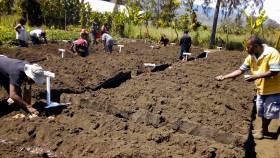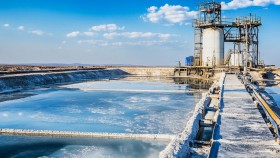ANU at core of steeling industry for a cleaner future
Researchers at The Australian National University (ANU) are at the core of a national program to transition Australia's industrial sector to producing resources such as steel and other heavy metals via zero net carbon emissions hydrogen technology.
The Heavy Industry Low-carbon Transition Cooperative Research Centre (HILT CRC) is doing the heavy lifting on maximising the carbon-neutral technologies thanks to $39 million from the Australian Government over the next 10 years and substantial funding by industry and universities.
The government funding, announced by Minister for Industry, Science and Technology Christian Porter, comes on the back of more than $175 million in investment from Australian industry, ANU and other Australian and international universities.
ANU College of Engineering and Computer Science Associate Professor John Pye said the University is making a substantial investment at the coalface of the project.
"We're looking at processes for making green steel using renewable energy like solar and wind, which, if implemented, could eliminate up to nine per cent of global CO2 emissions," Associate Professor Pye said.
"Australia is a big exporter of iron ore, so as this program goes forward we'll partner with big tech companies to see how we can work together."
The transition to carbon-neutral technology is a key focus at ANU. The University's Below Zero Initiative was launched in May and the ANU Grand Challenge Zero Carbon Energy for the Asia-Pacific program, where ANU led research on carbon-neutral technologies, began in 2018.
"This CRC will build upon strengths at ANU, including the momentum and diverse team that we've built up during our Zero Carbon Energy for the Asia Pacific," Associate Professor Pye said.
The CRC will also work collaboratively with industry in regional Australia where the transformational research will be applied. It will be headquartered at the University of Adelaide with hubs in Gladstone, Northern Tasmania, the Upper Spencer Gulf in South Australia, the Kwinana, Pilbara and the South West regions of Western Australia, the Southern Highlands of NSW and the Portland region of Victoria - all areas where heavy industry operates.
Director of the Centre for Energy Technology at the University of Adelaide Professor Graham Nathan, who led the successful bid for the HILT CRC, said heavy industry produces materials such as steel, aluminium and cement, which are vital to the national and global economy.
"Unlike electricity and transport, large and bespoke processing plants cannot use off-the-shelf technologies to tap into renewable energies like solar power and hydrogen fuel," Professor Nathan said.
"Research leaders will work with our partner companies and their industry experts to refine and demonstrate rapidly developing low emissions energy technologies, such as hydrogen production and concentrated solar thermal technologies, to their large industrial processes to enable them to thrive and grow in the new international markets."
The CRC partners will work together to reduce heavy industry's CO2 emissions which account for some 20 per cent of Australia's total output. The industrial sector globally accounts for 32 per cent of all CO2 emissions, of which approximately half are from the heavy industrial sector.
"Our analysis indicates that the increased competitiveness could provide an additional 376,000 direct and indirect jobs and contribute up to an additional $120 billion into the Australian economy," Professor Nathan said.
More information, including a full list of all the partners, is on the Heavy Industry Low-carbon Transition Cooperative Research Centre website.











